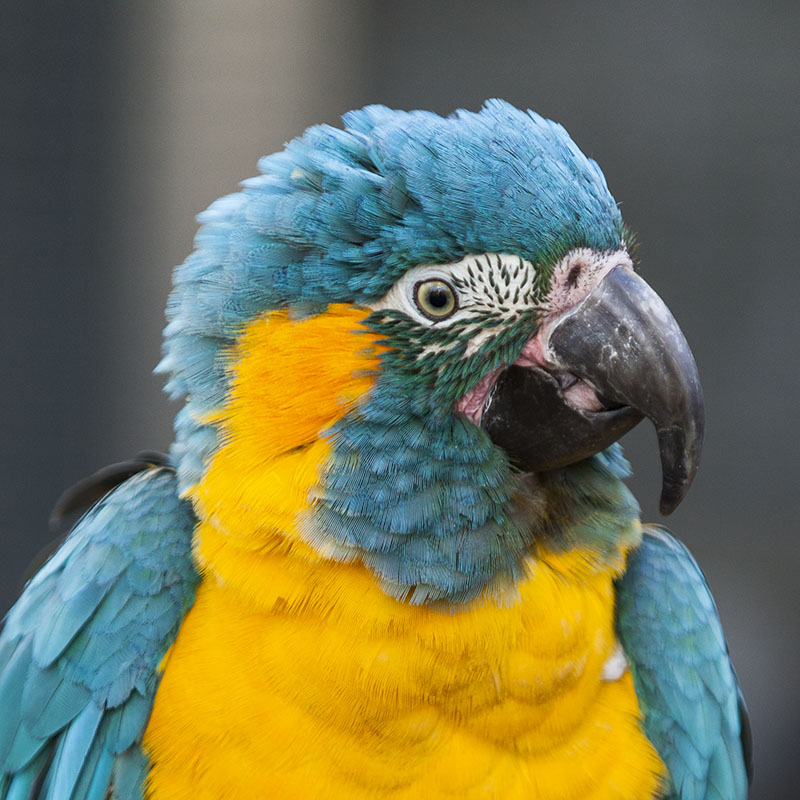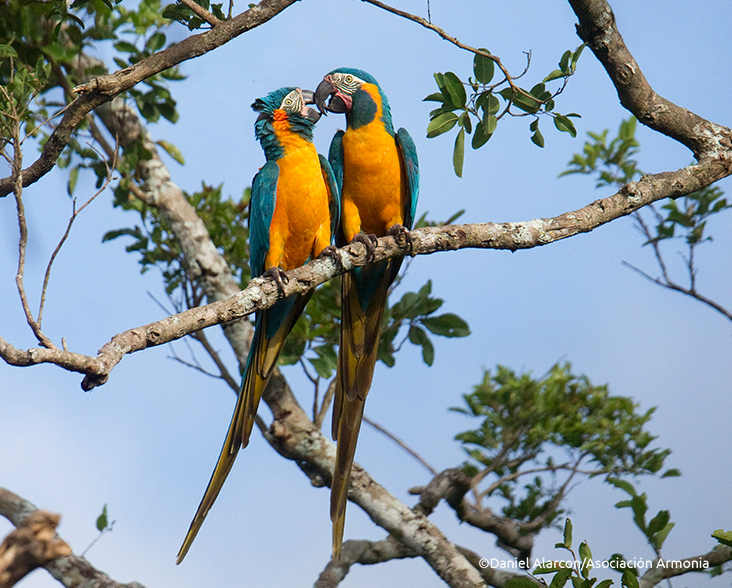
The Blue-throated Macaw (Ara glaucogularis) is a critically endangered species of macaw native to a small area in north-central Bolivia. It is notable for its striking appearance and limited range.
🦜 Key Facts
- Scientific Name: Ara glaucogularis
- Common Name: Blue-throated Macaw
- Conservation Status: Critically Endangered (IUCN Red List)
- Population Estimate: Fewer than 500 individuals in the wild
- Habitat: Llanos de Moxos—seasonally flooded savannas with forest islands
- Range: Endemic to Bolivia
🧬 Identification
- Size: 85–90 cm (33–35 in)
- Coloration:
- Bright turquoise-blue upperparts and wings
- Vibrant yellow underparts
- Distinctive blue throat and cheeks
- Bare facial patch with lines of black feathering
🌿 Behavior and Ecology
- Diet: Primarily fruits, nuts, and seeds—especially palm fruits like Attalea phalerata (Motacú palm)
- Breeding: Nests in cavities of large trees or palms, typically raising one chick per season
- Social Structure: Often seen in pairs or small groups
⚠️ Threats
- Habitat Loss: Deforestation for agriculture and cattle grazing
- Illegal Pet Trade: Captured for sale, especially during the 20th century
- Low Reproductive Rate: Slow breeding cycle hampers population recovery
💡 Conservation Efforts
- Captive Breeding Programs: Several zoos and foundations globally support breeding and reintroduction
- Land Protection: Conservation organizations have secured critical habitat areas
- Community Involvement: Education and incentive programs to protect nests and habitat




Here are some wonderful photos showcasing the striking Blue‑throated Macaw (Ara glaucogularis). You can see its vivid turquoise-blue back and wings, bright yellow underparts, and the signature blue throat patch that gives this species its name.
🦜 About the Blue‑throated Macaw
- Appearance: About 85 cm long, with a wingspan close to 90 cm. They have turquoise-blue upperparts, intense yellow underparts, and a distinctive blue throat and cheeks set in bare facial patches with horizontal feather lines worldlifeexpectancy.com+14en.wikipedia.org+14parrots.lars-bodin.dk+14parrots.org+2animaldiversity.org+2seaworld.org+2.
- Lifespan: In captivity, they can live up to 50 years, and even exceed 80 years in some cases nationalgeographic.com+2nationalgeographic.com+2zoobarcelona.cat+2.
📍 Distribution & Habitat
- Native to Northern Bolivia, especially the Beni savanna (Llanos de Moxos), where they inhabit forest islands and gallery forests dominated by Motacú palms (Attalea phalerata) between elevations of 200–300 m nationalgeographic.com+10en.wikipedia.org+10animaldiversity.org+10.
🍃 Behavior & Diet
- Diet: Primarily feeds on palm fruits (Motacú, Acrocomia, Mauritia) and plays a crucial role in seed dispersal worldlifeexpectancy.com+14parrots.org+14wildark.org+14.
- Social Structure: Social birds often seen in pairs, family groups, or roosting flocks (occasionally up to 70 birds); they forage daily and communicate via loud calls parrots.org+6avianhq.com+6en.wikipedia.org+6.
- Reproduction: Breeding season runs from November to March; nests are built in tree/palm cavities, with a clutch of 1–3 eggs and an incubation period around 26–29 days worldlandtrust.org+4seaworld.org+4wildark.org+4.
⚠️ Conservation Status
- Critically Endangered: With approximately 200–450 mature individuals in the wild avianhq.com+8worldlandtrust.org+8worldlandtrust.org+8.
- Major Threats:
- Habitat loss due to ranching, tree clearing, and burning.
- Historical and ongoing illegal trapping for the pet trade.
- Competition for nesting sites, predation, fire impacts wildark.orgavianhq.com.
- Conservation Measures:
- Nest protection and installation of artificial nest boxes.
- Legal protection in Bolivia; designated as National Natural Patrimony.
- Captive breeding programs (e.g., Loro Parque Fundación, Asociación Armonía) with hundreds of birds hatched and several hundred chicks fledged successfully avianhq.com+1parrots.org+1seaworld.org+3en.wikipedia.org+3en.wikipedia.org+3en.wikipedia.org+2abcbirds.org+2loroparque-fundacion.org+2.